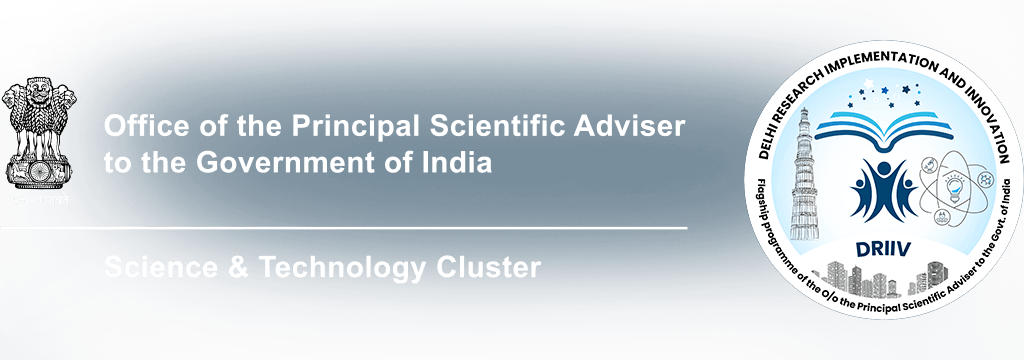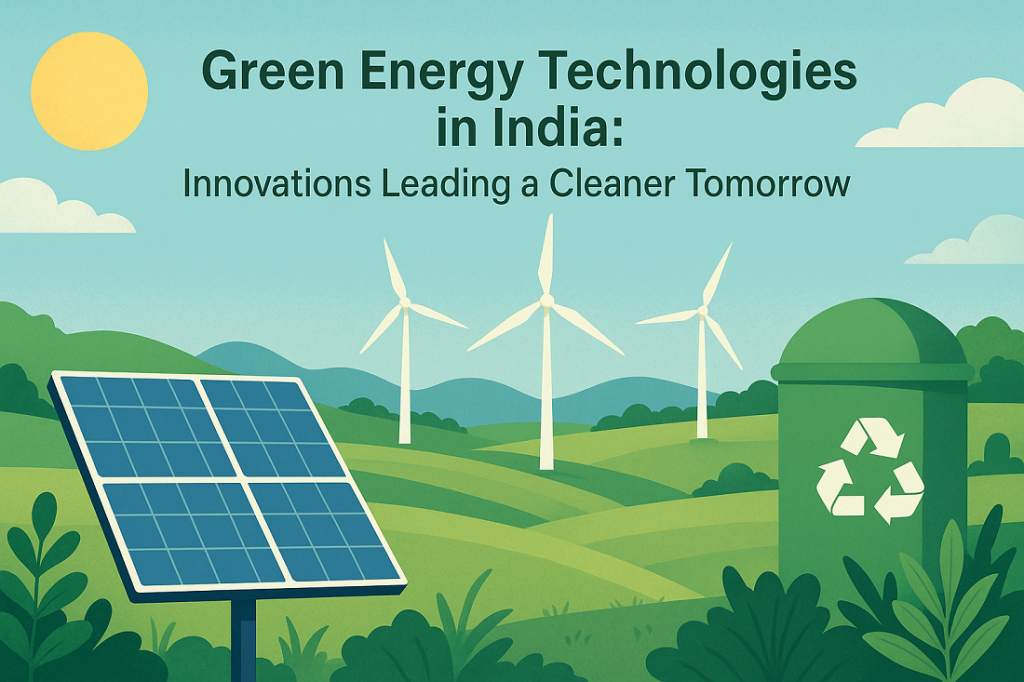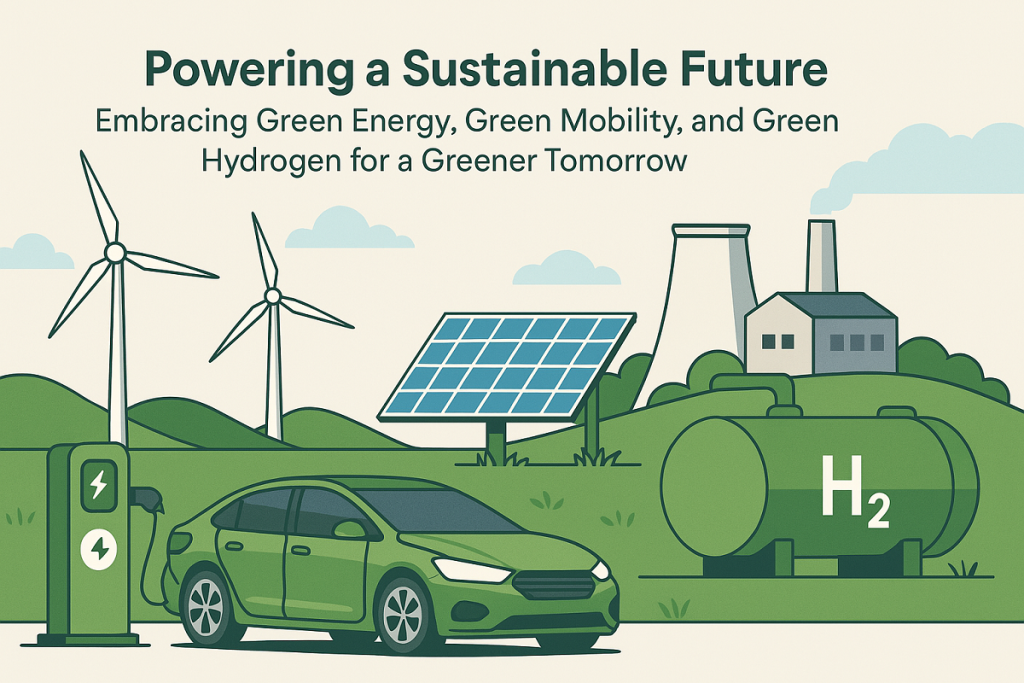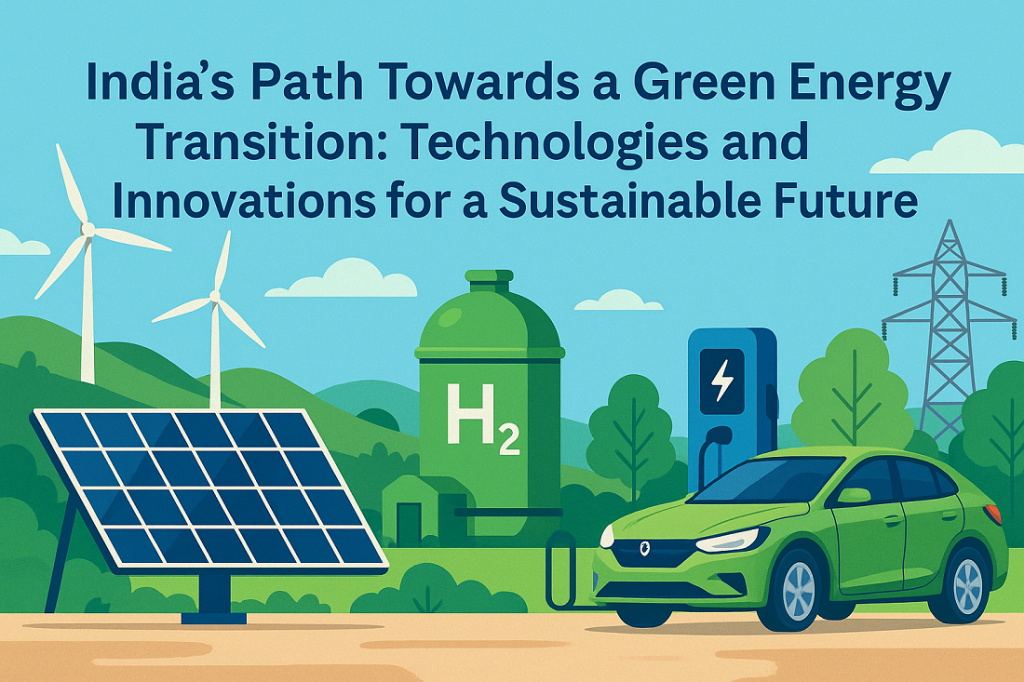India is standing at the crossroads of development and sustainability. With rising pollution levels, energy demands, and climate challenges, the country needs powerful and practical solutions. One of the most promising answers lies in green energy technologies.
From Green Hydrogen to Green Mobility, and from innovative solar applications to the Green Energy Transition, India is embracing a future built on clean power. These changes are not just ideas — they are already shaping the energy landscape and building a sustainable tomorrow.
In this blog, we will explore how green energy technologies are transforming India, highlight key innovations, and show how DRIIV and other forward-looking organizations are powering this green shift.
What Are Green Energy Technologies?
Green energy technologies are systems, methods, or devices that produce clean, renewable energy with little or no environmental harm. They include:
- Solar Power Systems
- Wind Energy
- Green Hydrogen Production
- Electric Vehicles (EVs)
- Bioenergy and Biomass
- Energy Storage and Smart Grids
Unlike fossil fuels, these technologies don’t pollute the air, water, or soil. They are sustainable and offer long-term economic and environmental benefits.
India’s Green Energy Transition: A National Priority
India is actively shifting towards clean power as part of its Green Energy Transition. The government has set ambitious goals:
- 500 GW of non-fossil fuel capacity by 2030
- Net-zero carbon emissions by 2070
- National Green Hydrogen Mission with ₹19,744 crore investment
- Faster adoption of Green Mobility with EV subsidies and infrastructure
India is no longer just a participant — it’s becoming a global leader in green energy technologies.
Solar Energy: Powering Millions with the Sun
India has quickly become one of the top solar power producers in the world. Solar energy is clean, abundant, and suitable for both urban and rural areas.
Key Innovations in Solar:
- Floating Solar Farms: Installed on lakes and reservoirs
- Solar Rooftop Programs: For homes, schools, and factories
- Solar-Powered Cold Storage: Helps farmers preserve crops
- Off-grid Solar Kits: Provide energy in remote villages
These solutions are helping millions of Indians reduce electricity bills and carbon footprints.
Wind Energy: Harnessing India’s Natural Wind Corridors
India’s coastline and mountain ranges provide strong wind potential. Wind farms in Tamil Nadu, Gujarat, and Maharashtra are producing large-scale clean energy.
Innovation in Wind:
- Hybrid Projects: Combining solar and wind in one location
- Small-Scale Wind Turbines: For local communities
- Wind-Solar Integration: For consistent energy supply
- Wind energy, along with solar, plays a key role in India’s green energy transition.
- Green Mobility: Driving Towards a Cleaner Future
Green Mobility refers to using clean, non-polluting methods of transportation — especially Electric Vehicles (EVs).
What’s Changing?
- Government-backed FAME II scheme (Faster Adoption and Manufacturing of Electric Vehicles)
- More EV charging stations in urban and rural areas
- EVs in public transport: Buses, autos, and taxis
- Battery-swapping and smart-charging networks
With increasing affordability and innovation, Green Mobility is taking root across India.
Green Hydrogen: Fuel of the Future
Green Hydrogen is produced by splitting water using renewable electricity, leaving zero emissions. It’s a versatile fuel for industries, vehicles, and power generation.
Why is it important?
- Can replace coal in steel, cement, and fertilizer industries
- Powers fuel-cell EVs with longer range than battery EVs
- Stores excess renewable energy
India’s Green Hydrogen Plans:
- National Green Hydrogen Mission aims to produce 5 MMT (million metric tonnes) annually by 2030
- Export potential to Europe and Asia
- Creation of Hydrogen hubs for local use and industry
Green Hydrogen could transform India into a global clean energy hub.
Energy Storage: Making Green Energy Reliable
Renewable sources like solar and wind are not available 24/7. That’s where energy storage technologies come in.
Innovations:
- Lithium-ion and Sodium-ion Batteries
- Pumped Hydro Storage
- Thermal Storage Systems
- Smart Grids to balance supply and demand
These solutions ensure that clean energy is always available — day or night, sun or rain.
Bioenergy: Using Waste as Power
India generates a huge amount of agricultural and organic waste. With bioenergy, this waste becomes a valuable green solution.
Innovations in Bioenergy:
- Biogas plants in villages using cow dung and kitchen waste
- Biomass power plants using crop residue
- Ethanol blending in petrol to reduce oil imports
Bioenergy supports rural economies and reduces pollution — a win-win for everyone.
How DRIIV Is Contributing to Green Energy Innovations
As part of India’s push for sustainability, DRIIV (Delhi Research Implementation and Innovation) is playing a vital role in driving impactful solutions.
DRIIV’s Contributions:
- Co-creating sustainable green energy technologies with research institutions and startups
- Supporting Green Hydrogen pilots and clean mobility programs
- Promoting AI-driven energy management systems for smart cities
- Piloting clean-tech incubation centers for green startups
At DRIIV, innovation meets implementation — ensuring technologies not only exist but also reach those who need them.
Benefits of Green Energy for India
Economic Growth
- Reduces oil imports
- Creates green jobs
- Lowers energy costs in the long run
Environmental Protection
- Lowers CO2 and air pollution
- Prevents land and water degradation
Energy Security
- Reduces dependence on fossil fuels
- Increases energy independence
Social Impact
- Brings electricity to remote areas
- Supports inclusive development
India’s shift to green energy technologies ensures growth with responsibility.
🌏 India’s Global Role in Green Energy
India is a founding member of the International Solar Alliance and part of global climate initiatives. With its innovation capacity, large market, and political will, India is seen as a global leader in clean energy.
From exporting solar modules to building Green Hydrogen partnerships, India is helping the world move toward a cleaner tomorrow.
What’s Next for Green Energy in India?
Predictions for 2030 and beyond:
- EVs will make up 30-40% of all vehicles
- India will be one of the top 3 producers of Green Hydrogen
- Solar energy will power most rural and semi-urban areas
- Smart cities will run on AI-managed clean grids
- Green jobs will grow across every sector
The future is not just green — it’s bright, inclusive, and sustainable.
Conclusion
India’s journey toward clean energy is not a dream; it’s a well-planned mission supported by innovation, investment, and intention. Green energy technologies are at the heart of this transformation.
With Green Mobility, Green Hydrogen, renewable energy systems, and innovative green solutions, India is truly building a cleaner tomorrow.
DRIIV stands proudly at the center of this change — driving research, enabling implementation, and powering progress.
Frequently Asked Questions (FAQs)
1. What are green energy technologies?
Green energy technologies are methods or tools that produce energy using renewable sources like solar, wind, or water with minimal environmental impact.
2. What is Green Hydrogen?
Green Hydrogen is a clean fuel created by splitting water molecules using renewable electricity, producing zero emissions.
3. What is the goal of India’s Green Energy Transition?
India aims to reach 500 GW of non-fossil fuel capacity by 2030 and achieve net-zero emissions by 2070.
4. How is India promoting Green Mobility?
Through subsidies for EVs, charging infrastructure, smart battery systems, and promotion of electric public transport.
5. What role does DRIIV play in the green energy space?
DRIIV promotes the co-creation and implementation of green energy technologies through research, pilots, and partnerships with academia, industry, and government.
6. How can individuals support green energy in India?
By installing solar panels, using electric vehicles, saving electricity, and supporting eco-friendly brands.
If you want to be part of India’s green energy revolution, stay connected with DRIIV. Together, we can build a future that is not only innovative but also sustainable.




